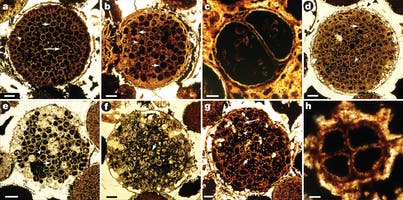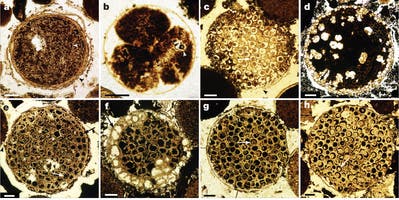Some bizarre spherical fossils found in China may be remnants of some of the world’s earliest animals (not unicellular organisms). A recent analysis has revealed that they are not bacteria or single celled protists, but rather algae, or even embryos from early animals.
“The real value of these fossils is that we now have some direct evidence about how this transition from single-celled organisms to things like animals and plants occurred in the evolutionary past,” said study researcher Shuhai Xiao, a geobiologist at Virginia Tech in Blacksburg
The cells have been dated to 600 million years. How this dating technique works is that they don’t date the fossils directly, but the formation in which they were found (the Doushantuo Formation). The fossils are known as Megasphaera and measure a mere 0.03 inches (0.7 millimeters) across. They lived in what was likely a shallow marine environment.
At the first examination, researchers believed they were dealing with some bacteria formations, but further investigations revealed that it was something else. They look just like what you’d expect from an undeveloped embryo, but the problem is that no animal which could have produced the embryos was ever found in that time period. The only other plausible alternative would be algae.

Specimen with cell packets in the centre and slightly elongate monads in the periphery. Xiao et al, 2014
In order to reach these conclusions, paleontologists sliced thin sections of the formation – so thing that light passes through them. Using microscopy, they observed several cells, cramped together in spherical clusters. The cells were different from one another in shape and size, which means that they were developing different tissues — a process known as cell differentiation — presumably with different cellular functions, Xiao said. This is a clear sign of a multicellular organism.
“That is a telling sign of the complexity of multicellular organisms that you don’t find in bacteria or protists,” he said.
The question which then arises is: are the fossils animal, or plant? The study seems to indicate signs of an animal.
“The bottom line is that they are multicelled and that they have cellular differentiation and that they have separation of reproductive cells from sterile somatic [body] cells,” Xiao said. “This is a big thing, because if you look at modern multicellular organisms, including animals, this is a critical step towards very complex multicellular organisms.”
However, it seems clear that the cells represent a transition stage from unicellular organisms, to multicellular organisms – and this transition is believed to have occurred initially in plants, not in animals. Furthermore, if these are the embryos… then where are the adults? The only way to settle these questions is finding more specimens and determine a pattern.
“We will have to be open-minded in terms of what can be expected,” Xiao said. “From the living animal point of view, we only have a certain morphology to go with. But there are extinct animals or even offshoots of the lineages leading to animals that could be rather different from what we know as animals living today.”
Journal Reference: Lei Chen,Shuhai Xiao,Ke Pang,Chuanming Zhou& Xunlai Yuan. Cell differentiation and germ–soma separation in Ediacaran animal embryo-like fossils. Nature (2014) doi:10.1038/nature13766










